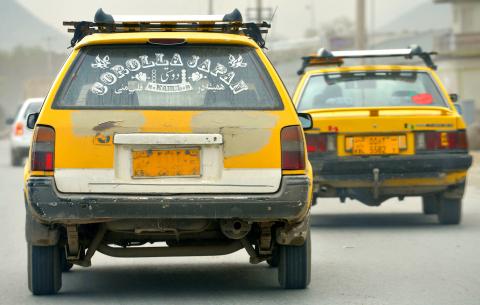Cheap, robust and reliable: Consumer culture may be relatively new to Afghanistan, but when it comes to cars, there is a clear favorite — the trusty Toyota Corolla.
In a country where even paved roads in the smartest parts of the capital are riddled with potholes, the sturdy Japanese-made car is the vehicle of choice for all but the richest.
“There have been Toyota Corollas here before it was even produced in Japan,” jokes Mohammad, a Kabul resident in his 30s who works for a foreign company.

Photo: AFP
Mirwais Nabizada, 38, who has sold used cars in Kabul for 20 years, says that they are popular because they are not as pricey as other vehicles — and spare parts are easy to find.
“Many people buy them because they are robust, cheaper and there are spare parts available everywhere,” he says.
He has 70 cars in his showroom, all but six of them Corollas.

Photo: AFP
They come in all shapes and colors: black, blue, green, yellow or white. Some have tinted windows, some don’t. Others have a curved chassis or square headlights. Old or new, it is always a trusty Corolla sedan.
“White is a favorite of buyers because it shows the dirt less, there is a lot of dust here,” Nabizada says.
On one 10-minute drive between the center of the capital and the embassy district, Agence France-Presse counted 194 Corollas, compared with 89 other cars, buses, trucks and security vehicles.
Owners love them and cherish them. They put stickers on their rear windscreens reading: “Beautiful Corolla,” “Super Saloon Corolla” and “Corolla I love you.”
Experts can recognize whether the vehicle comes originally from North America or Europe from the size of its bumper or the position of its license plate.
Almost all taxis are Corollas and customers who call a cab are not told the make, just to look out for a “gray 2002” or a “brown 2007.”
The head of Kabul traffic police, General Asadullah Khan, says Corollas account for 80 percent of the 700,000 vehicles driving through the congested streets of Kabul — where 500 to 600 new or used vehicles are registered each day.
“The Corolla is the car of the people. It doesn’t use too much gas,” he said.
However, their ubiquity also makes them the weapon of choice for Taliban car bombers, who stash them with explosives and drive unnoticed through checkpoints as they fight against the US-backed government.
With potential buyers wary of growing insecurity when the NATO combat troops leave next year, sales are down as people become more reluctant to spend money on a car when they feel uncertain about what the future holds.
Although they are cheaper than other cars available, Corollas are still no bargain due to high taxes — a dented old wreck costs US$3,500 while a one-year-old with low mileage goes for US$26,000.
Customs fees for each imported car are about US$5,000, plus US$1,500 for licensing and a range of other taxes to be paid on top, says Nabizada, who says that he sells only five a day, down from 10 a few years ago.
Still, existing owners continue to pamper and preserve their beloved Corollas.
“In Islam, cleanliness is an important value,” said Shaker Bakhter, one of the few dealers in Kabul, who says he has sold at least 10,000 Corollas in his career.
And why do Afghans pay so much for their cars?
“You foreigners spend your money by going dancing or bowling. We invest in what is useful,” Bakhter said.

China’s Huawei Technologies Co (華為) plans to start mass-producing its most advanced artificial intelligence (AI) chip in the first quarter of next year, even as it struggles to make enough chips due to US restrictions, two people familiar with the matter said. The telecoms conglomerate has sent samples of the Ascend 910C — its newest chip, meant to rival those made by US chipmaker Nvidia Corp — to some technology firms and started taking orders, the sources told Reuters. The 910C is being made by top Chinese contract chipmaker Semiconductor Manufacturing International Corp (SMIC, 中芯) on its N+2 process, but a lack

TECH BOOST: New TSMC wafer fabs in Arizona are to dramatically improve US advanced chip production, a report by market research firm TrendForce said With Taiwan Semiconductor Manufacturing Co (TSMC, 台積電) pouring large funds into Arizona, the US is expected to see an improvement in its status to become the second-largest maker of advanced semiconductors in 2027, Taipei-based market researcher TrendForce Corp (集邦科技) said in a report last week. TrendForce estimates the US would account for a 21 percent share in the global advanced integrated circuit (IC) production market by 2027, sharply up from the current 9 percent, as TSMC is investing US$65 billion to build three wafer fabs in Arizona, the report said. TrendForce defined the advanced chipmaking processes as the 7-nanometer process or more

NVIDIA PLATFORM: Hon Hai’s Mexican facility is to begin production early next year and a Taiwan site is to enter production next month, Nvidia wrote on its blog Hon Hai Precision Industry Co (鴻海精密), the world’s biggest electronics manufacturer, yesterday said it is expanding production capacity of artificial intelligence (AI) servers based on Nvidia Corp’s Blackwell chips in Taiwan, the US and Mexico to cope with rising demand. Hon Hai’s new AI-enabled factories are to use Nvidia’s Omnivores platform to create 3D digital twins to plan and simulate automated production lines at a factory in Hsinchu, the company said in a statement. Nvidia’s Omnivores platform is for developing industrial AI simulation applications and helps bring facilities online faster. Hon Hai’s Mexican facility is to begin production early next year and the

Who would not want a social media audience that grows without new content? During the three years she paused production of her short do-it-yourself (DIY) farmer’s lifestyle videos, Chinese vlogger Li Ziqi (李子柒), 34, has seen her YouTube subscribers increase to 20.2 million from about 14 million. While YouTube is banned in China, her fan base there — although not the size of YouTube’s MrBeast, who has 330 million subscribers — is close to 100 million across the country’s social media platforms Douyin (抖音), Sina Weibo (新浪微博) and Xiaohongshu (小紅書). When Li finally released new videos last week — ending what has